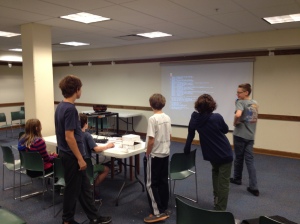
Raspberry Pi is a trademark of the Raspberry Pi Foundation.
I have a regular technology club that meets twice a month after school at the library. It’s made up of middle and young high school students, and since its inception last year, I’ve really tried to follow their lead in the projects we pursue. This fall, when we started up and all of last year’s teens joined back up and I gained some new kids, we had to shift around a bit before deciding on our projects. I showed them some of the toys, tools, and robots that we’ve reviewed here at Robot Test Kitchen, and finally they settled on something that I had heard about for a while but learned more about at a recent Tinker meeting. It’s a project that I felt both totally comfortable with, because it’s really just a computer, and completely intimidated by, because it’s a teeny tiny computer that runs an OS I haven’t played with since grad school.
Robot Basics:
- What is it?
Raspberry Pi is a fully functioning palm sized computer that runs Linux.
- What’s in the Box?

Cana Kit Complete Raspberry Pi B+ Starter Kit
You can purchase just the Pi, or you can buy a kit that comes with some essential components. I purchased the Cana Kit Complete Starter Kit, which comes with the following (from the website):
-Raspberry Pi Model B+ (B Plus) – Made in the UK!
– High Quality Case
– 2.5A USB Power Supply specially designed for the Raspberry Pi with Micro USB Cable
– 8 GB SD Card – Original Raspberry Pi Foundation Recommended SD Card with the new NOOBS
– CanaKit WiFi Dongle (Ralink RT5370 chipset)
– High Quality Case
– Premium Quality HDMI Cable
– A handy CanaKit General Assembly Guide for Beginners to Electronics.
- How Much?
This kit retails for $69.95. I purchased them on Amazon for about $56.
- Age Range?
This is tricky, because since it’s a computer, it can be used by anyone who can use a computer. If you want to use it as a project platform, the target ages would be older elementary and up.
- How Did We Acquire it?
I purchased it for my library with funds supplied by our Library Friends.
Ideas for Use
Our plan is to install Minecraft Pi, the Raspberry Pi edition of Minecraft, which includes the ability to do more mods than would otherwise be available. I’m excited about the seemingly endless potential too.
Time Involved
I had a pretty hands-off approach as the teens loaded up the first of the three kits I purchased. It took a little under an hour for them to explore the components, start the configuration process, work through some stumbling blocks caused by a failure to read before clicking “yes,” troubleshoot, and finally get to the usable desktop.
One-time or Recurring Program
This is definitely a recurring program, unless your library has some Pis and a specific one-time program that you intend to run with the Pis.
Skills You Need
I was comfortable facilitating this with what I’d consider to be “advanced general user” computer skills and a few conversations with some folks more well versed in Linux, the Pi, and other related topics.
Other Tools You Need
Here’s where they’ll getcha. I’ve seen the Pi touted as a “fully functioning computer for just $35.” This is true… but you will need other things in order to make it work.
-A power source. You can buy one for under $10 or use a 5v power source that you might have around the house leftover from an old cell phone.
-A microSD card for the B or B+ model, or a miniSD card for the A. Again, you might have one of these already. If not, you can purchase one. I saw the recommended 8G card at Microcenter on sale for about $5.
-A wifi dongle. Again, maybe you’ve got one, maybe you don’t want to use the Internet, maybe you’ll want to buy one for about $10.
-An HDMI cable. You’ll need to connect it to a monitor (or a projector in our case). These can be had for about $10.
-A USB keyboard
-A USB mouse
-A monitor or projector
Given the above needs, I felt that the Cana Kit was a good value.
Good Stuff

Waiting for the configuration to finish up. Basically just like Mission Control at NASA.
When was the last time you saw a bunch of teens excited to see a whole screen full of command line code? It was really neat to give the kids a box, tell them to figure out what was in it, and then figure out how to make it run. Pretty cool. Also, though this felt like a very advanced project, there is definitely a level of comfort and familiarity knowing that at it’s core, it’s a computer just like what I’m familiar with using.
Frustrations
I had this great idea that since most of our teens have school assigned Chromebooks, we could rig the Pis up to take advantage of the keyboard, display, and trackpad on the Chromebooks. It would be great! Compact, no need to store extra monitors, and inexpensive for the library. It is possible, but due to the filters and use agreements that the kids are bound by, it is not something we’re able to do right now.
Ending Thoughts/Observations
I’m glad I’m tacking this. I thought it was out of my league, but I’m letting the teens lead and they are really happy doing it so far. They even plan to meet while I’m out of town at ILEADUSA during our next scheduled meeting!
Overall Rating:
Proceed with caution. Only because it’s not a one time program, it’s really the first step in a commitment to more in-depth projects.

3 thoughts on “Review: A tiny taste of Raspberry Pi”